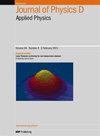Addressing variability in cell electrorotation through holographic imaging and correction factors
IF 3.1
3区 物理与天体物理
Q2 PHYSICS, APPLIED
引用次数: 0
Abstract
This study addresses the variations observed in electrorotation measurements due to cell positioning and movement. Electrorotation provides a non-disruptive method for inferring the electrical properties of individual cells. However, its widespread adoption is hindered by significant variation in the observed speed. By mitigating the impact of positional dependencies and other influencing factors, our methodology opens avenues for broader applications of electrorotation in single-cell analysis without the need for complex setups to trap and retain the cell in place. Our novel approach combines multi-plane imaging with mathematical treatment of rotation data. This method uses a conventional quadrupole chip and lens-free imaging to track cell movement, resulting in a simpler design and set-up. Through numerical simulations incorporating cell coordinates, chip design, and experimental parameters, we calculate the variation in torque for each position. These values serve as the basis for the correction factors. Validation experiments with T-lymphocytes and fibroblasts show that the correction factors reduce electrorotation speed variation due to cell movement, with an average reduction to 21% and 18%, respectively. These corrections also revealed previously concealed changes in cell properties, in response to external stimuli, thereby enhancing the reliability of measurements and enabling broader applications in single-cell analysis.通过全息成像和校正因子解决细胞电otation的可变性问题
本研究探讨了电otation测量中观察到的因细胞定位和移动而产生的变化。电旋转是推断单个细胞电特性的一种非破坏性方法。然而,由于观察到的速度存在显著差异,这种方法的广泛应用受到了阻碍。通过减轻位置依赖性和其他影响因素的影响,我们的方法为电otation在单细胞分析中的更广泛应用开辟了途径,而无需复杂的设置来捕获和固定细胞。我们的新方法将多平面成像与旋转数据的数学处理相结合。这种方法使用传统的四极芯片和无透镜成像来跟踪细胞运动,从而简化了设计和设置。通过结合细胞坐标、芯片设计和实验参数的数值模拟,我们计算出了每个位置的扭矩变化。这些数值是校正因子的基础。用 T 淋巴细胞和成纤维细胞进行的验证实验表明,校正因子减少了细胞运动引起的电转速度变化,平均降幅分别为 21% 和 18%。这些校正因子还揭示了细胞特性在外部刺激下发生的先前被掩盖的变化,从而提高了测量的可靠性,使单细胞分析的应用更加广泛。
本文章由计算机程序翻译,如有差异,请以英文原文为准。
求助全文
约1分钟内获得全文
求助全文
来源期刊
CiteScore
6.80
自引率
8.80%
发文量
835
审稿时长
2.1 months
期刊介绍:
This journal is concerned with all aspects of applied physics research, from biophysics, magnetism, plasmas and semiconductors to the structure and properties of matter.

 求助内容:
求助内容: 应助结果提醒方式:
应助结果提醒方式:


